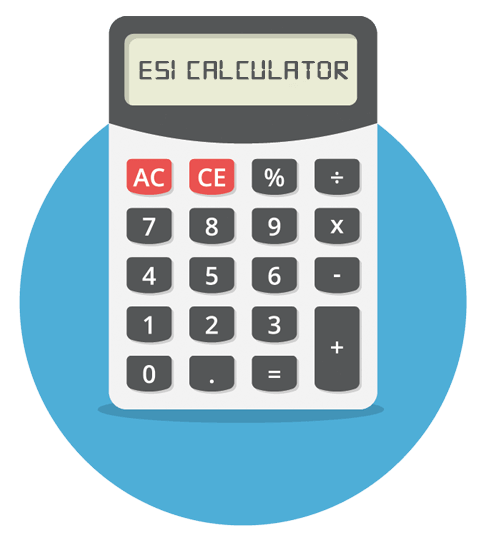
ESI stands for Employee State Insurance managed by the Employee State Insurance Corporation which is an autonomous body created by the law under the Ministry of Labour and Employment, Government of India.
This scheme was started for Indian workers. The workers are provided with a huge variety of medical, monetary and other benefits from the employer.
Eligibility
The scheme is applicable in certain areas and applies to all factories and establishments, as defined in the Act, employing 10 or more employees. The wage limit currently is Rs 21,000.
Contribution
Under this scheme, earlier the rate of contribution was 6.5% which was further reduced to 4% w.e.f. 01 July, 2019.
| Old Contribution Rate | Revised Contribution Rate | |
| Employee | 1.75% | 0.75% |
| Employer | 4.75% | 3.25% |
The only exception to the employee in paying his contribution is whose salary is less than Rs. 176/- per day. That means if an employee is earning less than 176/- a day his contribution will be zero. However, employers will contribute their share for these employees.
What salary components are applicable to ESI deductions?
ESI contributions (from the employee and employer) are calculated on the employee’s gross monthly salary.
Most people face challenges in understanding ESI deduction rules because they aren’t clear about the concept of Gross Salary. So, let us explain this concept first.
Gross salary is described as the total income earned by the employee, while working in their job, before any deductions are made for health insurance, social security and state and federal taxes.
For ESI calculation, the salary comprises of all the monthly payable amounts such as
– Basic pay
– Dearness allowance
– House Rent Allowance (HRA)
– Incentives (including sales commissions)
– Attendance and overtime payments
– Meal allowance
– Uniform allowance and
– Any other special allowances
The gross monthly salary, however, does not include Annual bonus (such as Diwali bonus), Retrenchment compensation, and Encashment of leave and gratuity.
ESI Calculations
The rates of contribution, as a percentage of gross wages payable to the employees, is explained in the table below
| Percentage of Gross Pay | Example Gross Salary | Contributions | |
| Employee Deduction | 0.75% | Rs 15,000 | 15,000 * 0.75% = 112.50 |
| Employer Contribution | 3.25% | 15,000 * 3.25% = 487.50 | |
| Total Contributions for this employee | 112.50 + 487.50 = Rs 600.00 |
In case, the gross salary of the employee exceeds Rs. 21,000 during the contribution period, the ESI contributions would be calculated on the new salary and not Rs 21,000.
For example, if the salary of an employee increases to Rs. 22,000 per month, then the ESI would be calculated on Rs. 22,000 instead of Rs. 21,000 during the contribution period.
Contribution Period
There are two contribution periods each of six months duration and two corresponding benefit periods also of six months duration.
| Contribution Period | Cash Benefit Period |
| 1st April to 30th September | 1st January of the following year to 30th June |
| 1st October to 31st March of the following year | 1st July to 31st December |
After the commencement of a contribution period, even if the gross salary of an employee exceeds Rs. 21,000 monthly, the employee continues to be covered under ESI scheme till the end of that contribution period.
The contribution is deducted on the new salary. Let us look at an example to understand this better.
If an employee’s gross salary increases in June from Rs. 18,000 (within ESI limit) to Rs. 22,000 (above ESI limit), the deductions for ESI will continue to happen till the end of the ESI contribution period i.e. September.
And the deduction amount for both the employee and employer will be calculated on the increased gross salary of Rs. 22,000.
At the end of the contribution period, if the employee salary is more than the ESI limit, no further deductions and contributions are required. The employee will still be covered under ESI till 30th June of the following year.
Similar rules apply when an employees salary increases in the 2nd contribution period.
ESI contribution late payment interest/damages
ESI contribution has to be made every month. The last date of ESI contribution payment for any month is the 15th of the succeeding month. This means that you need to pay the ESI challan for the month of April before the 15th of May.
If you miss your payment deadline before the 15th of the month, then you are susceptible to additional interest and damages on your total ESI due amount.
The employer incurs a late payment interest of 12% per annum. On the other hand, the damages incurred are on the basis of slab division. These damage slab categories are as follows:
| Period of delay | Rate of damages in % p.a. |
| i) Less than 2 months | 5 % |
| ii) 2 to 4 months | 10 % |
| iii) 4 to 6 months | 15 % |
| iv) 6 months and above | 25 % |
For example,
1 Lakh contribution delayed by 12 months, Then simple interest payable is 12,000/-
| Period of delay | Rate of damages in % p.a. | Amount |
| i) Less than 2 months | 5 % | 833/- |
| ii) 2 to 4 months | 10 % | 1667/- |
| iii) 4 to 6 months | 15 % | 2500/- |
| iv) 6 months and above | 25 % | 12500 |
| Total Interest + Damages | 29,500/- |
These are the rates of the additional damages that you need to pay in the case of delay of ESI payment. But the total damages amount cannot exceed 100% of the total due amount. Even the total interest cannot exceed the total due amount.
